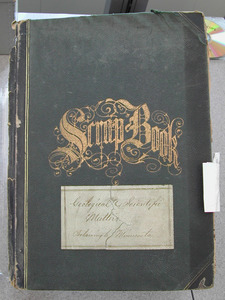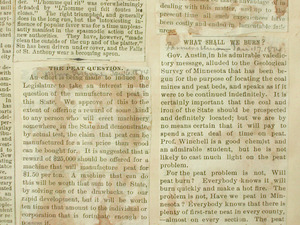The second full year of work on the Minnesota Geological and Natural History Survey was a busy one for State Geologist Newton Horace Winchell. First, he was directed by the governor and the state legislature to settle once and for all the question of the development of salt production from a salt spring well in Bell Plaine. Winchell ultimately determined that the physical attributes of the region where the well was drilled lacked the right geological seasoning in order to be able to sustain salt production. With that geological matter settled, the legislature assigned Winchell the task of solving some questions about another natural resource: peat. Where did it exist in the state? Could it be used as a fuel source? Was it a less-costly alternative to wood and coal? Existing opinions amongst the farmers and settlers of the state, in addition to the printed editorial opinions of state newspapers on the matter kept Winchell bogged down as he conducted his investigations…
 The Newton Horace Winchell papers contain a scrapbook titled, “Geological and Scientific Matters Pertaining to Minnesota.” The pages of the scrapbook contain hand-clipped newspaper articles that date back to as early as 1872. To several pages are affixed articles that document the peat saga as it unfolded in 1873.
The Newton Horace Winchell papers contain a scrapbook titled, “Geological and Scientific Matters Pertaining to Minnesota.” The pages of the scrapbook contain hand-clipped newspaper articles that date back to as early as 1872. To several pages are affixed articles that document the peat saga as it unfolded in 1873.
In order to seek assistance in locating significant sources of peat within the state, Winchell wrote letters to the editors of both the Minneapolis Tribune and the St. Paul Pioneer newspapers. In the letters, which were published in both newspapers on July 15, 1873, Winchell informed the public of his legislative mandate, requested assistance from citizens in collecting peat samples, and acknowledged that “it would be impossible for one man to visit and obtain samples from all the peat deposits of the State.” Winchell gave instructions on how to obtain and record the samples, and also indicated that expenses related to the transmission of the samples would be paid by the Survey.
The Tribune took an early interest – and objection – to the entire peat matter. In “Our Peat Beds” (unknown date of publication), the paper editorialized:
“Professor Winchell, State Geologist, calls for co-operation in locating the peat beds of Minnesota, in accordance with the laws of the last Legislature. While we hope the co-operation will be cheerfully given, we doubt the practical value of the location of peat bogs. There are peat bogs all over the country – a good one in almost every county – but they are of no value to the owners or anybody else at present. Five years ago a peat excitement swept over the land, something like the tulip fever and the mulberry fever of a former time, and large areas of peat beds changed hands; but the end of it was sudden collapse, because it was found that there was no machine by which the article of fuel could be quickly and economically prepared…… When some genius will make a machine that will dig the peat in large quantities, compress it into bricks, expel the water and dry it, expeditiously and cheaply, with little manual labor, perhaps it may be worthwhile to put Prof. Winchell to the trouble of hunting of the oldest peat-beds and labeling them.”
After Winchell visited the Windom area in the southwest portion of the state, The Windom Reporter published an account of the geologist’s visit and reported that he found a large quantity of peat that had good prospect of being developed into a stable fuel source for the farmers in the area. The Tribune issued a criticism of the positive account in the Reporter in another editorial titled, “Our Peat Quarries”:
“The Windom Reporter is very much gratified that the Professor has found good peat bogs in that vicinity and it proceeds to anticipate that peat ‘will be of invaluable benefit to the people for fuel,’ and that ‘it will be more advantageous to farmers to quarry peat for their winters’ fuel than to depend upon wood…
…This is very plausible, but it is erroneous and misleading. We assure the farmers of Minnesota that it will not pay for them to touch peat for general fuel… We assure the Windom Reporter that peat is a gay deceiver, and we ask it to co-operate with us in exposing its perfidious character. “
In January of 1874 the Tribune offered a reward of $25,000 to the man who invented a machine that could “demonstrate, by actual test, the claim that peat can be manufactured for a less price than wood can be bought for.” After offering the amount, the newspaper was contacted by men throughout the country who assured that they had the machinery to process peat for fuel and inquired as to where the peat fields were located in Minnesota. The Tribune invited all those interested, “Bring on your machines, and practically demonstrate what you claim – that you can make a good article of peat for from $1 to $1.59 per ton – and your fortunes are made.”
The Farmers Union took on a less audacious tone in an editorial published January 17, 1874 titled, “What shall we burn?” The article began with, “We are by no means certain that it will pay to spend a great deal of time on peat,” and continued to outline the argument for or against the use of peat as fuel in simple terms:
“For the peat problem is not, Will peat burn? Everybody knows it will burn quickly and make a hot fire. The problem is not, have we peat in Minnesota? Everybody knows that there is plenty of first-rate peat in every county, almost in every section. The peat problem is, How can peat be economically manufactured into fuel that is compact and portable? This is the only question there is unsolved – and it is a question, not for the chemist’s retort, but for the ingenuity of the mechanic and inventor…
… what is the use of expending the money of the State and the labors of Professor Winchell? Gentlemen may get as excited as they please about peat, for enthusiasm is cheap and pleasant; but we feel sure that Minnesota must, for many years yet, warm their feet and cook her dinners by the use of wood.”

In the Second Annual Report of the Survey, an entire chapter is devoted to Winchell’s peat investigations of 1873. In addition to an exhaustive introduction of what peat actually is and a comprehensive explanation of all processes that have been devised to utilize peat as fuel, Winchell reported 43 distinct locations within Minnesota where he found existence of peat, and provided specific details about samples taken from each site. Thirty-nine pages of the annual report are devoted to peat, to include a complete chemical analysis of samples by Survey chemist, S. F. Peckham. In the final section, Winchell provided “Practical conclusions on peat” that were not too far from what the newspapers had been editorializing all along:
“1. There is not so much real peat in the state of Minnesota as has been supposed.
2. While a good fuel, almost equal to the Iowa coal, can be produced by the manufacture of peat by a process of condensation and evaporation, it is far from certain that it will not cost as much, or more than wood or coal at the present prices…
… 11. The value of peat as a common fuel having been demonstrated, and its existence in sufficient quantities within the state having been ascertained, it becomes a legitimate expedient for the State to stimulate the invention of successful methods of utilizing it by offering rewards.”
I’m peat-ered out on this topic, as I’m sure Winchell was as he traveled the state, auger in hand, collecting samples of decomposed earth. Fortunately for Winchell, the investigations of 1873 pretty much summed up his peat work. Also, Winchell wasn’t bogged down for long. The Board of Regents Meeting Minutes reveal that for his third year of Survey work, Winchell was granted permission to take a field trip:
From the Board of Regents Meeting and Committee Meetings 1869-1887, June 18, 1874:
“Prof. Winchell stated to the Board that he had been invited by Col. Ludlow to accompany the military and scientific expedition to the Black Hills in Dakota: on motion of Regent Marshall the invitation was accepted, and Prof. Winchell was authorized to go, it being understood that no part of the expenses shall be borne by the University: On motion of Regent Sibley, the sum of one hundred dollars was appropriated from the general fund to aid Prof. Winchell in collecting specimens for the Geological and Natural History Survey.”
Join us next time, when we abandon the peat bogs of rural Minnesota and follow Winchell to the wild and exotic “Dakotas” for year three of the Minnesota Geological and Natural History Survey…